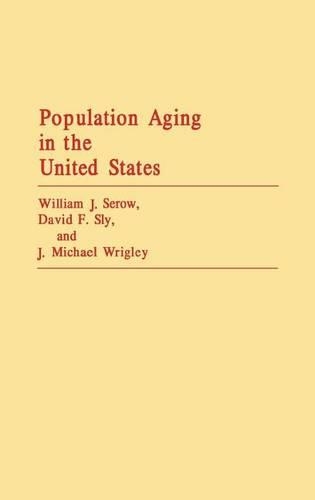
Population Aging in the United States
(Hardback)
Publishing Details
Population Aging in the United States
By (Author) William J. Serow
By (author) David F. Sly
By (author) J. Michael Wrigley
Bloomsbury Publishing PLC
Praeger Publishers Inc
26th June 1990
United States
Classifications
Tertiary Education
Non Fiction
305.260973
Physical Properties
Hardback
240
Description
This incisive work reviews the salient aspects of the demographic, social, and economic characteristics of the aging of the population of the United States. It deals not only with the past and current aspects of population aging but also emphasizes the future outlook with regard to characteristics of the elderly and relative size and composition of the future older population. The book begins with a retrospective review of the population aging process of the United States throughout the twentieth century and continues with a prospective view of aging through most of the next century. Through the use of 67 tables, the authors go on to consider the demographic determinants of population aging and examine the role that each of the three demographic processes has actually played in the shaping of the status quo, as well as the roles that they may play in the future. Succeeding chapters are devoted to spatial aspects of aging in the United States; various social and economic aspects of aging and the older population in the United States; economic characteristics of previous, current, and future generations of older Americans with a focus on labor force, income, and educational attainment; and health status and patterns of health care utilization among older Americans. A final chapter brings all the preceding material together by considering the policy implications of prospective population aging within the United States with reference to both the increased number and proportion of older persons within the American population and to the aging of the older population itself during the next century. This reference work is a must for all professionals in demography and gerontology. It also deserves close attention by those taking courses in social gerontology and demography.
Reviews
An excellent work by established demographers familiar with gerontological data sets. The book looks at how prior levels of fertility, mortality, and migration determine characteristics of an aging population. Beginning with a brief review of population aging in the US and how it compares with the rest of the world, the authors describe how fertility, migration, and, particularly, declining mortality have shaped the current situation. They analyze spatial aspects of aging in the US, focusing on both rural-urban differences and on the comparative importance of migration versus aging in place. Marital status, living arrangements, and housing characteristics of the aged are considered. The authors also assess trends in labor-force participation, income levels by age and gender differentials, and how the educational attainment gap is closing. The study addresses health status, access to an utilization of health care, and the economic implication for funding this care. The last chapter considers policy implications of aging in the US, with particular attention to health care, economic well being, and intergenerational relationships. The work includes many figures (22) and tables (47), but they are relatively easy to interpret. Unfortunately, the tables are not typeset and lack some visual clarity. Appendix (nine tables) and end-of-book references. Highly recommended for serious students of demography or gerontology.-Choice
"An excellent work by established demographers familiar with gerontological data sets. The book looks at how prior levels of fertility, mortality, and migration determine characteristics of an aging population. Beginning with a brief review of population aging in the US and how it compares with the rest of the world, the authors describe how fertility, migration, and, particularly, declining mortality have shaped the current situation. They analyze spatial aspects of aging in the US, focusing on both rural-urban differences and on the comparative importance of migration versus aging in place. Marital status, living arrangements, and housing characteristics of the aged are considered. The authors also assess trends in labor-force participation, income levels by age and gender differentials, and how the educational attainment gap is closing. The study addresses health status, access to an utilization of health care, and the economic implication for funding this care. The last chapter considers policy implications of aging in the US, with particular attention to health care, economic well being, and intergenerational relationships. The work includes many figures (22) and tables (47), but they are relatively easy to interpret. Unfortunately, the tables are not typeset and lack some visual clarity. Appendix (nine tables) and end-of-book references. Highly recommended for serious students of demography or gerontology."-Choice
Author Bio
WILLIAM J. SEROW is Associate Director of the Center for the Study of Population and Professor of Economics at Florida State University. He is the author of many articles and books on topics relating to migration, small area demography, population economics, and the demographic and economic aspects of aging. DAVID F. SLY is Director of the Center for the Study of Population and Professor of Sociology at Florida State Universtiy. He is the author of many articles and books on topics relating to migration, urbanization, human ecology, and the demographic and social aspects of aging. J. MICHAEL WRIGLEY has been a Postdoctoral Fellow at the Center for Demographic Studies at Duke University since 1988. He is the author of several articles on health and mortality, migration, and human ecology.
